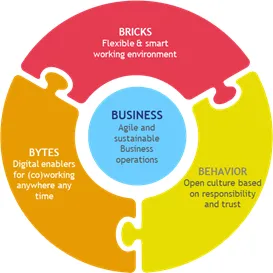VITO shifts to more flexible working
The corona crisis and periods of mandatory home working have also brought about change at VITO. The past two years have been a learning and growth trajectory that has had an impact on our physical and digital workplace, our way of working together, with each other and with partners and clients.

Corona leads to a different way of working
Like many other organisations, the corona crisis forced VITO to change the way of working and collaborating in a very short time.
The already initiated modernisation of the digital working environment accelerated drastically. Experiments with new ways of meeting and communicating were carried out. Even the work organisation from before the corona crisis was being questioned: what positive elements can we take with us from the corona crisis and how can we turn these into sustainable work practices? Is it necessary for all employees to be present in the office? Can we limit the number of work trips by other efficient forms of consultation ...?
In order to provide an answer to these questions, VITO set up the internal working group 'Work Organisation of the Future' in early 2021. The working group set a series of objectives and starting points and looked at them from 4 perspectives: Bricks, Bytes, Behaviour and Business. The first three are in service of the needs of the organisation and our customers (Business). One thing was certain: working at VITO will look quite different after the corona pandemic.

What you do, determines where you work
A first important change in VITO's work organisation is that the activities and interactions of employees will determine where they work. Our offices will therefore no longer be the standard workplace for every employee. Those who do not have a job function related to a fixed location can work elsewhere, such as at home, at a customer or partner organisation, in one of our other buildings, etc.
Important here is that each team makes clear agreements on how they will function in this new context. Questions such as 'When will we be together in the office, what are we planning for that day, how will we indicate events in our agendas? The team members formalised all team agreements in agreement frameworks.
Redesign of the workspaces
Together with the decision to let employees decide where they work depending on their activities, we reviewed the role of our buildings. After analysing the buildings, it was decided to redesign them with a focus on flexibility and interaction. Specifically, the buildings will have different zones and anchor points, where employees can carry out any type of activity optimally, individually or in teams.
After a long period of working from home, we will start using this new way of working in March and build on our work organisation of the future together.


